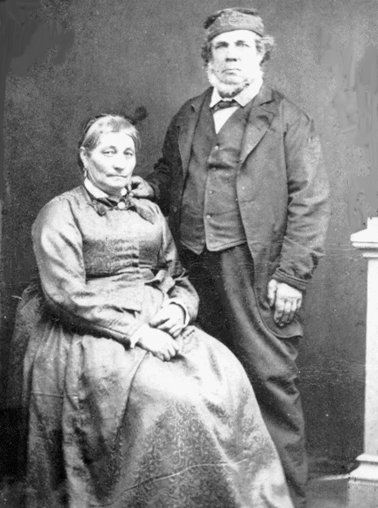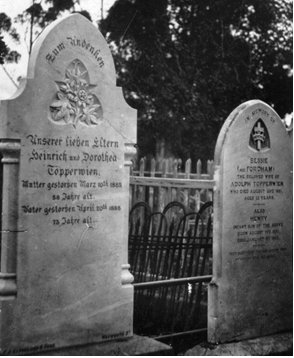The TOPPERWIEN Family HistoryHeinrich and Dorothea TOPPERWIENClick here to view the TOPPERWIEN Family Tree,Click here to view the FOX - TOPPERWIEN Family Tree, |
|
The connection between the NEWMAN family and the TOPPERWIEN family was made when Dina NEWMAN married Eldon FOX whose mother was Ivy May TOPPERWIEN. |
|
Heinrich Philipp TOPPERWIEN
|
|
Heinrich Philipp and Dorothea Topperwien were the parents of August Carl Topperwien, the grandparents of Ivy May Topperwien and the great grandparents of Eldon Fox. August Carl was their fifth child. We can only guess at the reasons why Heinrich Philipp and Dorothea Topperwien emigrated to Australia for we have no direct evidence, but in the 1840s in Germany there was a period of social, political and religious disruption and turmoil. Toward the 1840s a severe business depression halted industrial expansion and aggravated the existing high unemployment in the cities. In the countryside serious crop failures caused disastrous famines throughout northern Europe. The lack of food resulted in hunger riots in a number of the German states. This social unrest was further inflamed by the news in 1848 that the French government had been overthrown by an insurrection in Paris in February of that year. This resulted in a series of sympathetic revolutions against the governments of the German states. However, by the middle of 1849 the uprisings had been put down and the hopes of the liberals for democracy were crushed. These political problems were compounded by religious problems in some of the German states. In Prussia and other states in the German Confederation, the government attempted to settle long standing religious disputes by forcing dissenters to accept the discipline of an orthodox and state-sanctioned Lutheran Church. Prussia endeavoured to compel the acceptance of a revised liturgy. This resulted in conscientious resistance and a grouping of dissenters in separate sects. As in England when the Stuarts sought to force uniformity on the Puritans, these German dissenters sought refuge and religious freedom overseas in a new land. Whereas the Puritans founded colonies in North America, the Germans established settlements in Australia, mainly in South Australia and Queensland. Another factor in the emigration to Australia was the fall in the price of lead and silver. The Harz Mountains, which was the home of Philipp and Dorothea, contained lead and miners were active at Glen silver mines which had been worked for hundreds of years. From 1825 onwards, the metals extracted from the mines in South America flooded the European markets and put many of the Harz miners out of work. The Topperwien and Bremmer families, although not miners, were dependent on the mines for their livelihoods. The Hannovarian government assisted many of these people to emigrate to Brazil, Mexico, Texas and South Australia. In South Australia these German miners were active at Glen Osmond, Kapunda and Burra. After the collapse of the Burra mine in the 1870s many German miners moved to Broken Hill. |
|
|
|
It would appear probable that these are the reasons that Heinrich Philipp and Dorothea emigrated to South Australia from Lanau, near Hannover, Germany. Heinrich Philipp and Dorothea departed from Hamburg, Germany, on 2nd May 1849 on the Australia under Captain W H Sleebohm. They sailed first to Rio de Janeiro, where they landed on 23rd July 1849 and arrived at Port Adelaide on Wednesday, 12th September 1849.Heinrich was the son of Johann Conrad Topperwien and Johanne Christiane Topperwien. Dorothea was the daughter of Caspar and Henriette Bremmer, nee Rohrmann. They were married on 17th April 1849, only 15 days before they left Germany. Johann Topperwien and Caspar Bremmer were both Kohlermeisters (master charcoal manufacturers). The manufacture of charcoal was vital to the smelting of metals from the mines in the Harz Mountains. With the collapse of the mines there was no need for the charcoal. After spending a short time in Adelaide where Heinrich worked on some panelling in a bank, the couple set off for Redruth. Heinrich Philipp and Dorothea walked alongside their German wagon, which carried Heinrich Philipp's carpenter's bench, his tools and their furniture, from Adelaide to Redruth, part of the copper mining town of Burra. They travelled between three and ten miles per day over poor tracks, often being forced to cross streams without the aid of bridges. It is hard to imagine how Dorothea coped, wearing the clothes she did. It is believed that when they arrived in Redruth that they lived in a dugout on the river bed until they established themselves there. In 1850 Burra was the seventh largest town in Australia, having a population of around 5,000. |
|
|
|
Heinrich Philipp and Dorothea had nine children. They were Albert Ernst (1850), Earnest August (1852), Ida Caroline Henrietta (1856), Adolph Gustave (1858), August Carl (1860), Fredericka Augusta Juliana (1862), Frederick August (1864), Ita Juliana (1866). As there was no Lutheran church in Burra until 1861 (and even then it was really just a chapel and was used more as a community centre than a church), the children, as in most other German families, were baptised in the St Mary's Church of England. However their eldest son was baptised by a Lutheran minister, Pastor Kapter in 1850. From information received from German relatives of Heinrich Philipp, I understand that he had a strong sense of humour and a light hearted view of life, at least in his younger years. It is said that he kept his coffin the house to scare the children. He kept apples in it. While living at Burra, Heinrich Philipp built the interior woodwork of the mines. |


